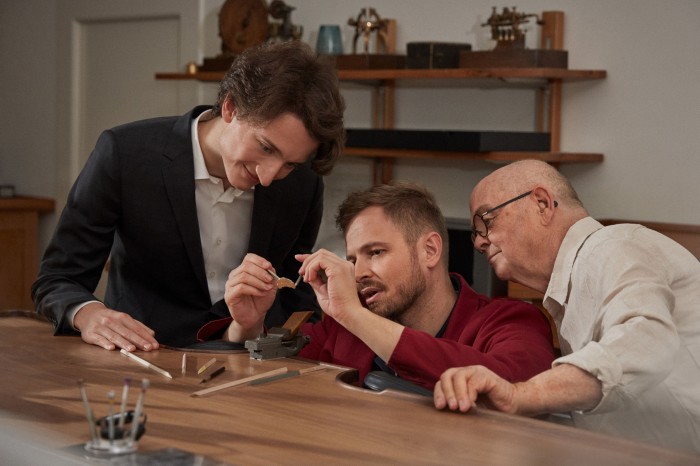Rexhep Rexhepi inaugurates Louis Vuitton’s watchmaker collaboration programme

Roula Khalaf, Editor of the FT, selects her favourite stories in this weekly newsletter.
For a young man who has been behind some of the most in-demand watches of recent times, Rexhep Rexhepi is keen to point out that collaborating with big brands is not necessarily his thing. On Monday in California, however, he will be revealed as the first to join Louis Vuitton’s five-year programme of collaborations with independent watchmakers.
This programme — the proceeds of which will support the LV watch prize — is set to begin in explosive fashion with a tourbillon chronographe sonnerie watch conceived, designed and, except for a few components, manufactured by Rexhepi.
Housed in a heavily reworked Tambour case — LV’s signature watch design — it features two dials: the front, transparent with plique a jour enamel; the back showing elapsed seconds and minutes on two tracks indicated by a central pair of hands. At the beginning of every minute counted by the chronograph, the sonnerie mechanism is activated and the watch chimes. With a price tag of around €500,000, only 10 of these watches will be sold.


It is 25 years since Rexhepi arrived in Geneva as a refugee fleeing war in Kosovo. Now, aged 36, his work holds its own with watchmakers twice his age, his name often mentioned in the same breath as Dufour, Journe and Voutilainen. He has won two prizes at the Grand Prix d’Horlogerie de Genève (GPHG), the Oscars of the watch world.
His workshop in Geneva’s old town is a place of pilgrimage. He is championed by such international industry heavyweights as Michael Tay, managing director of multi-brand watch retailer The Hour Glass in Singapore, as well as the leading family-run UAE retailer, Seddiqi Holding.
Rexhepi makes watches under two brand names: Akrivia, experimental in concept, contemporary in appearance; and Rexhep, the restrained classic codes of which are epitomised by the multi-award-winning Chronometre Contemporain.
The person who enticed Rexhepi into this project is none other than Jean Arnault, the fifth and youngest child of Bernard Arnault, founder and chief executive of LVMH. Since joining the family business in 2021, Arnault has done much to elevate the LV’s horological offer. He not only launched a redesigned Tambour but also announced that LV’s watch workshop, La Fabrique du Temps, would be reviving the Gerald Genta and Daniel Roth watch brands.
Arnault established a €150,000 prize for independent watchmaking, as well, which will benefit from sales of the Rexhepi watch launched in Montecito, California — an exclusive community known for its mountain trails and equestrian centres outside Santa Barbara.
With this innovative and complicated watch, Louis Vuitton has brought out one of the strongest contenders so far for the title of most desirable timepiece of 2023.
This is not the first time that programmes to support independent and relatively unknown watchmakers have been launched.
Maximilian Büsser, founder of boutique Swiss brand MB&F, did something similar in 2001 when he set up the Opus project at Harry Winston Rare Timepieces (now known as Harry Winston). But Arnault is quick to point out differences. “Here, we’re sticking to only five collaborations and every single one has been given the same brief: what is the favourite design that you see within LV watches? How can you put your own touch to it?
“It’s not something that we are counting on making millions or even thousands out of — it’s really about trying to make a mark in watchmaking history, so people remember that this was a move to champion independent watchmaking as a whole, and not necessarily looking at return on investment or any sort of profit.”
While Arnault may not be looking for profit, the costs associated with this type of limited edition project can be considerable for an independent watchmaker. This year, Rexhepi is also launching another new chronograph and an antimagnetic version of his Chronometre Contemporain. The LV collaboration diverts resources, both human and financial, from the main collection, plus it comes with its own expenses: a new movement can cost between SFr1.5mn-SFr2mn ($1.63mn-$2.18mn) to develop. Then there is the cost of manufacturing, but Rexhepi clearly considers the investment to be worthwhile. “We have to put the processes in place for doing this case, we have to put the processes in place for the polishing, the decoration, so it’s a really, really big investment,” he says.
Louis Vuitton will, in turn, handle the sale of the finished watches via its retail network. Collectors will be invited to purchase a watch, in consultation with Rexhepi.
“I’m not a big fan of collaborations like that,” Rexhepi admits quite freely. “But I had this idea for a chiming chronograph and thought maybe they [LV] will help us make people understand that we are not just watchmakers doing the decoration and assembling, we are really inventors. I just wanted to be the first [of the five independent watchmakers with whom LV is collaborating] and Jean was OK with that.”
As to the inevitable gossip that he might be acquired by LV, Rexhepi says that “people will always talk”. For him, it is less about business than it is mutual respect. “It is more about friendship,” he says. “Jean loves watches, he loves watchmaking, and I find it interesting to see a big brand working with a small watchmaker.”
According to Michael Tay, that personal relationship is crucial to understanding the true nature of the collaboration. “Fundamentally, Jean’s a product guy. This is something that would have motivated Rexhep. It is not just a brand that Rexhep is collaborating with, it is another passionate individual. If Jean was not there, I’m not sure Rexhep would have pulled the trigger on this project.”
Comments